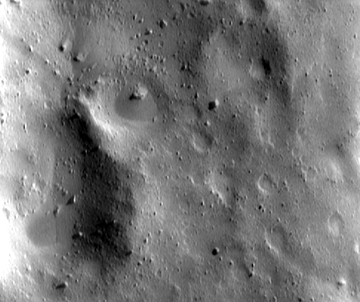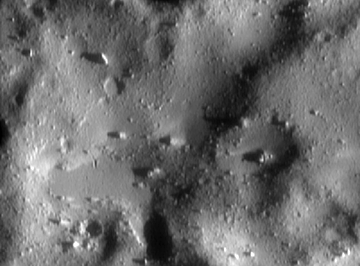Cornell imaging team hopes close-up pictures from asteroid landing will solve puzzle of never-before-seen surface features
By David Brand


As NASA's Near Earth Asteroid Rendezvous spacecraft, known as NEAR Shoemaker, closes in on asteroid 433 Eros, Cornell University astronomers hope that surface details as small as a hand-size rock will be captured by the camera before the spacecraft bumps down on the boulder-strewn surface Feb. 12.
Since last October, the NEAR imaging team has been puzzling over strange surface features of Eros seen in new, high-resolution images. There is the hope that the close-up images taken in the final few minutes before the spacecraft drops onto the surface will help to answer their questions about the geology of the 22-mile-long asteroid more than 196 million miles (316 million kilometers) from Earth.
"Since last October we have seen details of Eros at 1 meter resolution that we haven't seen anywhere else before and don't understand," says Cornell astronomer Joseph Veverka, who heads the imaging team. "That's why we are so excited about getting close to the surface."
The landing – what NASA is calling a "controlled descent" – is a highly risky maneuver, involving four thruster firings over four hours intended to slow the rate of descent to 7 mph from 20 mph. In the final 45 minutes, when the spacecraft is about 3.5 to 4.5 miles (about 6 to 7.5 kilometers) from its landing site at the edge of the crater Himeros, the camera will begin taking a new image about every 30 seconds.
The final picture will be captured at just 550 yards (500 meters) from the surface, enough to capture details as small as perhaps 4 inches (10 centimeters) across. Mission leaders at the Applied Physics Laboratory at Johns Hopkins University, which built the spacecraft and manages the NEAR mission, do not expect images to be transmitted from the surface because Eros's spin and topography will almost certainly prevent communication between Earth and the craft.
Why does Veverka's team want to get such a close look at Eros' surface details? Because, says Veverka, who is professor of astronomy at Cornell, his team is frankly puzzled by what it has seen on Eros over the past few weeks. Last October, with much of NEAR's mission accomplished, the spacecraft was sent into orbit just 4 miles (about 6 kilometers) or so from the asteroid's surface. For the first time the imaging team was seeing details as small as a yard (.9 meter) across, compared with the approximately 5.5 yards (5 meters) resolution that had been captured by the camera since the spacecraft went into orbit around Eros on Feb. 14, 2000.
"Suddenly, we started seeing things we didn't expect and hadn't seen on other surfaces in the solar system," says Veverka. "It's like another door has opened."
The biggest surprise, says Cornell researcher Peter Thomas, who has been interpreting the geology of the asteroid's surface, "is that some small craters and other small depressions have flat, smooth floors, unlike most craters you see on Eros and other objects. It looks as if fine-grain material has slid down the craters' sides and ponded in the bottoms." Apparently, he says, there is some mechanism "we hadn't anticipated" that moves fine-grain material around on the surface. Although gravity on Eros is only one one-thousandth of that on Earth – an average person would weigh only an ounce or two – it is still "very effective in gathering materials in very flat floors on the bottom of depressions."
Another surprise, says Veverka, is the discovery that some small boulders are surrounded by material that appears to have disintegrated from the boulders' surfaces. "There is some process that is very gentle that somehow disintegrates rock. We haven't seen this on the moon, and we haven't seen this before on Eros," he says. "But it seems to be very common."
It is just possible, says Veverka, that the final image will be taken almost at the surface itself. He explains that the camera will remain in focus until about 220 yards (200 meters) from the landing site. If the spacecraft is still on course, it is possible that the camera will take one final image and have time to send a partial image on its way to Earth before the spacecraft touches down. It takes 10 milliseconds for the exposure, 1 second to read the image into the spacecraft recorder and 30 seconds for the data to emerge from the recorder. The data then take 17 to 18 minutes to reach Earth tracking stations.
The imaging team now is getting even higher-resolution images of these features. On Jan. 24 the spacecraft entered a close flyby sequence, including a four-day orbit that produced images from as close as 2 miles (3.2 kilometers) above the surface. These new images are enabling the Cornell imaging team to accumulate data at a resolution of about 1.1 yards (1 meter). "The hope is that during the descent we can improve this resolution by perhaps a factor of 10 so that we can find out more about what is going on there," says Veverka.
Media Contact
Get Cornell news delivered right to your inbox.
Subscribe